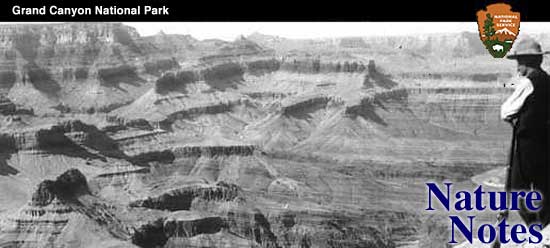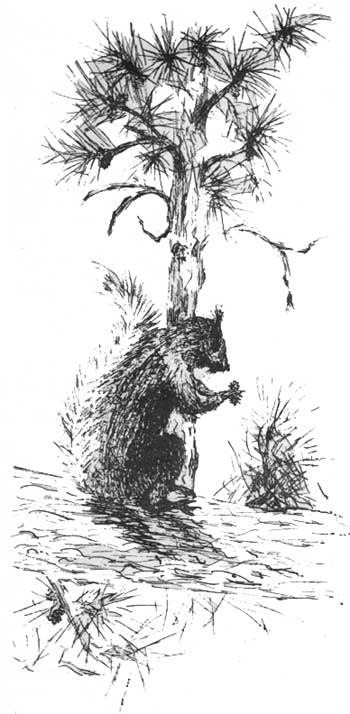

|
By Ranger Naturalist Ralph Redburn NOT OFTEN does one have the privilege and opportunity of studying the habits and nature of the white-tailed Kaibab Squirrel, Sciurus kaibabensis, both because of its very restricted range and because of its usual shyness. It is found only along the North Rim of the Grand Canyon, and in various areas in the Kaibab National Forest nearby. In the vicinity of the Public Auto Campground on the North Rim, however, one has exceptional opportunities of seeing this particular squirrel. It is the purpose of this article to record a few facts which have been observed concerning one family of them which lived at the campground. On July 1, 1932, camp attendant, Mr. Thomas, reported to me that he had watched a mother Kaibab squirrel transport her young to a new nest. Five babies in all were moved. They were carried beneath the breast of the mother, in an upside-down position with the tail extending back between the mother's fore legs. In this position the baby squirrels were able to support their own weight by grasping the fur of the mother with their small, yet long claws. Also, the mother held the babies by the neck with her mouth. Although this is a rather peculiar way in which to transport its young, the Abert Squirrel*, a relative of the Kaibab, also uses this method.
On the day following the report given me by Mr. Thomas, I made a trip to the campground for investigation of the recently discovered family. The old nest was located in a hollow portion of a dead yellow pine tree. This tree was near the campfire lecture site, and inasmuch as campfire talks were being given each evening, the mother probably thought the fire and the people about the place would be a menace to the schooling of her babies in the ways of nature. 
Therefore she moved them. The new nest was approximately forty feet from the ground in a very secure place among the branches of another yellow pine. The distance between the two trees measured 432 feet. Following this preliminary investigation, I climbed the tree in which the new nest was located. When I arrived within about eight feet of the nest, the mother suddenly jumped out, and began to scold with sharp, barking sounds and by stamping stiff-legged on branches of the tree. When arrived at the nest I discovered only one opening, and this was very well hidden under an overhanging branch. The nest was made of yellow pine twigs and needles, and was lined with ravelings from old carpet. Inside I found five well developed baby squirrels, none of which had reached that stage at which time the eyes open. The mother had moved these babies only a few days after birth. Upon being handled by me they would not make a sound, although they would squirm around a great deal. Meanwhile, the mother would come close, bark very loudly, then scamper away. I noticed that she was rather thin, so decided to provide the family with a feeding box containing various kinds of food. This was done, and the mother ate freely from it. Her favorite foods were pinyon nuts, bread crumbs, oats, and crackers. I visited the nest every day for a week, during which time the eyes of the young squirrels were still closed. Because of my frequent visits, the mother became somewhat accustomed to my presence and stopped her scolding, although she always remained close by to watch. She apparently did not appreciate my presence and finally went to another tree, built a new nest, and on the eighth day after the date of discovery moved her babies a second time. It so happened that I arrived at the time of moving and was able to locate the new site. I climbed the tree and investigated the nest which already contained four of the babies. They had their eyes open and when handled this time made queer squeaky sounds. Soon the mother arrived with the last young squirrel. Then she found that I was at the nest she placed her baby on a branch of the tree, and scampered up to drive me away. I climbed down to where she had left the baby. It looked at me with wide open eyes, then successfully tried to crawl along the branch. After this visit I did not return to the nest for ten days during which time the young squirrels developed very rapidly, and upon my return were cautiously traveling around in the tree, sampling various pine needles. Each squirrel was well marked and showed the characteristics of the species. The little tail which was almost as long as the body, was covered with short white hairs. The body was of a steel grey color, while the back was contrasted by the broad red brown stripe which ran from the base of the neck to the base of the tail. The stomach was a distinct black. The long hairs growing out from the tips of the ears made the head of the animal very attractive. Now that the squirrels are almost grown and run freely among the trees in the campground with the members of various other squirrel families, they are often seen by Grand Canyon visitors. We hope that the species is increasing in number and are glad to see that certain individuals are definitely becoming more tame. | ||||||
| <<< Previous | > Cover < | Next >>> |
vol7-7c.htm
14-Oct-2011